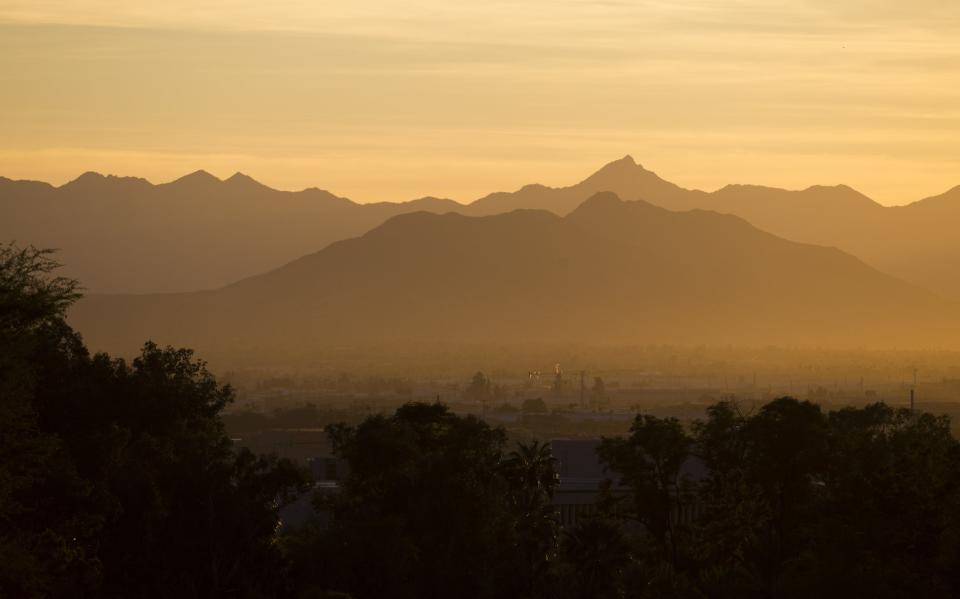GOP leaders, Arizona Chamber sue EPA over 'tyrannical' air quality standards
- Oops!Something went wrong.Please try again later.
- Oops!Something went wrong.Please try again later.
Corrections & Clarifications: A previous version of this article misidentified the University of Arizona school Paloma Beamer is affiliated with.
Republican leaders of the Arizona Legislature joined the Arizona Chamber of Commerce and Industry in a legal fight against the Environmental Protection Agency over a new air pollution standard they say will damage the economy.
In a petition filed Monday, Arizona Senate President Warren Petersen, House Speaker Ben Toma and the business group called the new standard for microscopic particulate matter known as PM 2.5 "arbitrary, capricious, an abuse of discretion" and illegal, and asked the court to declare it unlawful and vacate it.
"This rule will create unnecessary hardships for job creators and hardworking Arizonans," Petersen said in a written statement. "It will detrimentally impact our power grid and create even more red tape for both small and large businesses. We have no choice but to ask the courts to provide relief from this tyrannical, arbitrary, and illegal move by the EPA."
The petition for review filed in the United States Court of Appeals for the District of Columbia Circuit follows a court action three weeks ago by 24 Republican state attorneys general over the same rule. Arizona's Democratic Attorney General Kris Mayes didn't join the action.
What is PM 2.5 pollution?
Scientists have long recognized the danger of PM 2.5, which can seep through the lungs into the bloodstream and trigger a wide range of maladies, including strokes, heart attacks and asthma. The particles, which are 2.5 microns in diameter, are sourced mainly to smoke from wildfires, fireplaces and wood-burning ovens, but burning coal and some manufacturing processes also produce the pollution.
Several studies have shown the PM 2.5 affects people of color more than white people, possibly due to socioeconomic differences that cause emission sources like freeways, airports and manufacturing facilities to be closer to communities with more Black, Asian and Latino residents.

In Maricopa County, which has some of the worst air pollution in the country, PM 2.5 levels tend to be concentrated in west and south Phoenix. Wildfires, wood-burning fireplaces, smoke from fireworks, construction activities and tailpipe emissions are some of the primary local sources.
In 2021, the EPA decided to reconsider its decision to keep the annual standard for the pollution at 12 micrograms per cubic meter. That decision led to the finalization of the new standard last month of 9 micrograms per cubic meter. At the time, the EPA noted that the counties of Maricopa, Pinal and Santa Cruz were out of compliance with the new standard.
The EPA claims, based on several studies, that the new rule will prevent up to 4,500 premature deaths annually from PM 2.5, resulting in a national savings of up to $46 billion dollars by 2032, when many affected areas will achieve compliance.
Why are business leaders fighting the new rule?
Danny Seiden, president and CEO for the Arizona Chamber of Commerce and Industry, said other studies have shed doubt on those findings. Much of the PM 2.5 in metro Phoenix comes from sources the state can't control, like wildfires from other states or local residents burning wood.
Forcing the state to adhere to the new standard would cost the state billions of dollars even though compliance will be difficult or impossible to achieve, he said. The European Union, he pointed out, has an annual standard of 25 micrograms per cubic meter.
"If the stated goal under the Clean Air Act is to provide cleaner, healthier air, this decision makes no sense," he said.
Members of the business group want clean air, he said, but worry the rule will drive up manufacturing costs, leading companies to manufacture products in other countries while still failing to attain the "impossible" standard.
Reducing levels not 'impossible,' scientist says
Levels of PM 2.5 have declined nationally by 42% since 2000, according to the EPA.
University of Arizona scientist Paloma Beamer said the state can continue to reduce particulate matter without destroying its economy.
Beamer is an environmental health sciences professor and the director of the university's EPA-funded WEST Environmental Justice Center. She said focusing on trucks and trains, especially in low-income areas that see more traffic, could lead to cost-savings in terms of better health outcomes for residents.
"We are taking into account the cost on health," she said, adding that "anything that uses diesel is super-important" to the fight against PM 2.5.
Beamer said citizens can help the state determine where the problem areas are by purchasing or borrowing home air-quality detection kits that link together, displaying the problems regionally on the website map.purpleair.com.
Staffers at Democratic Gov. Katie Hobbs' office are still reviewing the Arizona petition to the Washington D.C. appeals court, said spokesperson Christian Slater.
Reach the reporter at rstern@arizonarepublic.com or 480-276-3237. Follow him on X @raystern.
This article originally appeared on Arizona Republic: GOP leaders, Arizona Chamber sue PA over new PM 2.5 standard

